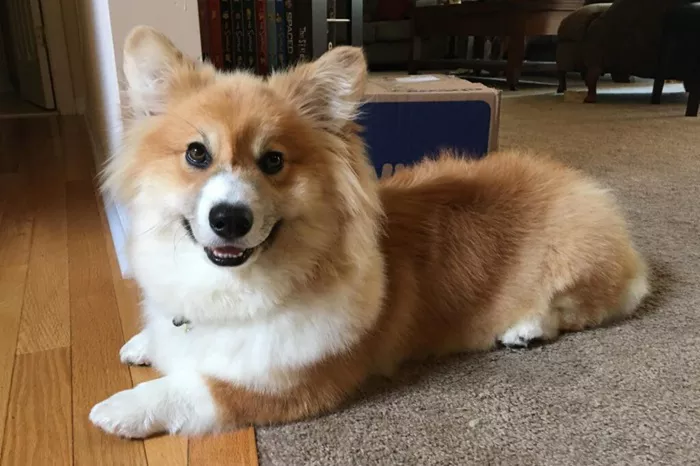Corgis have a double coat. This means they have a soft undercoat and a tougher outer layer. The undercoat keeps them warm, while the topcoat repels dirt and moisture. Cutting or shaving the coat improperly can damage its protective nature.
Why Regular Grooming Is Important
Grooming a Corgi is not just about looks. It helps manage shedding, prevents matting, and maintains skin health. Routine brushing and trimming also allow you to check for skin issues, parasites, or injuries.
Essential Tools for Cutting a Corgi’s Hair
High-Quality Clippers
Choose clippers designed for thick, double coats. Low-grade clippers may pull on the hair and cause discomfort.
Slicker Brush and Undercoat Rake
Before trimming, use a slicker brush to remove surface tangles. An undercoat rake helps thin the dense undercoat.
Grooming Scissors
Use rounded-tip scissors for trimming sensitive areas like the face, feet, and tail.
Detangling Spray and Pet-Safe Shampoo
A detangler helps with tough mats, while a mild shampoo cleans the coat without stripping natural oils.
Pre-Cut Preparations
Bath and Dry
Always start with a clean coat. Bathe the dog using warm water and a Corgi-appropriate shampoo. Dry thoroughly using a towel and low-heat dryer. Never cut a wet or damp coat.
Brushing Before Trimming
Brush out the entire coat to remove tangles. Focus on the neck, behind the ears, and under the legs. These are common spots for matting.
Calm Environment
Use a quiet, non-slippery surface. Keep your Corgi calm. Treats and praise help. Some owners use professional dog training techniques to get their pets used to grooming.
Step-by-Step Guide: How to Cut a Corgi’s Hair
1. Do Not Shave the Coat
Never shave a Corgi. Shaving removes the natural insulation and may damage the coat permanently. Focus on trimming and thinning, not full shaving.
2. Trim the Pants (Rear Thigh Hair)
Use thinning shears to reduce volume. Don’t remove all the fur. Just tidy up the fluff to avoid matting and collect less debris.
3. Trim the Hock and Feet
Clean up the area around the hock (lower back legs). Trim foot fur that sticks out between pads and toes. This helps with traction and cleanliness.
4. Feathering on the Legs
The long hair on the back of the legs, called feathering, should be shaped neatly. Use scissors to maintain a natural look.
5. Neck and Chest Area
Brush the ruff (mane) forward and trim for a rounded look. Always cut with the grain of the hair to avoid an uneven appearance.
6. Tail Grooming
Not all Corgis have long tails. For those that do, gently trim to remove split ends and keep the tail tidy.
7. Sanitary Trim
Use rounded scissors or small trimmers for the belly and rear end. This helps maintain hygiene and keeps debris away.
8. Ears and Face
Trim carefully around the ears. Do not cut into the ear canal. Clean with a soft cloth and avoid harsh chemicals. Trim whisker areas only if necessary.
How Often Should You Cut a Corgi’s Hair?
Routine Maintenance
Trimming should be done every 6 to 8 weeks. Brushing should be done at least twice a week to control shedding. Daily brushing is ideal during heavy shedding seasons.
Signs It’s Time for a Trim
If you notice matting, dragging hair, or clumps behind ears or under legs, it’s time to trim. Excess fur on paws and tail also indicates a need for grooming.
Common Mistakes to Avoid
Shaving the Coat
Again, never shave a double-coated dog like a Corgi. It can lead to heat stress and improper hair regrowth.
Using Dull Tools
Dull scissors or clippers can pull hair and cause injury. Always check and sharpen your tools regularly.
Skipping Detangling
Cutting through mats is painful. Always detangle first to prevent injury and discomfort.
Over-Trimming
Do not try to give your Corgi a “short haircut.” Their coat is meant to be thick. Trimming should only enhance the natural shape.
Professional Grooming vs. At-Home Grooming
When to Call a Professional
If your Corgi is matted or nervous, or you lack the right tools, hire a groomer. Professionals are trained to handle sensitive areas.
Benefits of DIY Grooming
Home grooming builds trust. It’s cost-effective and lets you monitor your dog’s health closely.
Post-Trimming Care Tips
Brush Often
Frequent brushing keeps the coat healthy and reduces shedding.
Watch for Skin Irritations
After cutting, inspect for red patches or cuts. Use pet-safe ointments as needed and consult a vet if irritation persists.
Keep Up with Other Grooming Tasks
Don’t forget nails, teeth, and ears. Grooming is more than just haircuts.
Seasonal Grooming Considerations
Spring and Fall Shedding
Corgis “blow” their undercoat during spring and fall. During these seasons, increase brushing frequency and consider a professional deshedding treatment.
Summer Trims
Do not cut the coat short in hot months. The double coat regulates temperature. Trim lightly and keep your Corgi indoors during peak heat.
Health and Behavior Benefits of Grooming
Skin and Coat Health
Regular grooming prevents buildup of dead hair and skin, allowing for healthier growth and reduced odor.
Improved Behavior
Well-groomed dogs are often more comfortable and less irritable. Grooming is also a bonding time, promoting trust and good behavior. With consistent handling, grooming becomes a stress-free routine. Some dogs respond well to professional dog training method to improve grooming tolerance.
Conclusion
Corgis are adorable, and their fluffy coats are a big part of their charm. With proper tools, the right methods, and consistent care, you can keep your Corgi comfortable and looking sharp without risking coat damage. Remember, grooming is about health and comfort—not just appearance. Trim gently, brush often, and know when to call in a pro. Let your Corgi’s natural beauty shine through careful maintenance
Related topics:
How Long Does Pressure Canned Meat Last?
How Much Should a 15 Pound Dog Eat a Day
6 Best Dog Food for Gastrointestinal Problems


